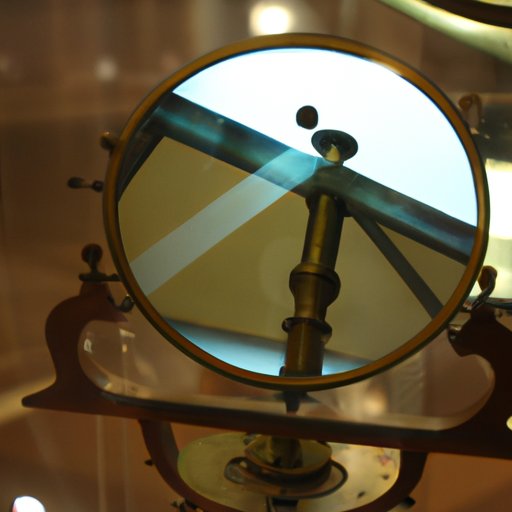Introduction
The mirror has been a part of human life since ancient times. It is a reflective device that has been used throughout history for various purposes, from personal grooming to scientific applications. But who invented the mirror? This article will explore the mystery of who invented the mirror, tracing its evolution through history, understanding the science behind its invention, and discovering the person responsible for this groundbreaking discovery.
A Historical Look at the Invention of the Mirror
The earliest known examples of mirrors date back to around 6000 BC and were found in Anatolia (modern-day Turkey). These primitive mirrors were made from polished stones such as obsidian, a volcanic glass. During the Bronze Age (3000-1200 BC), mirrors were made from metals such as copper and bronze, with handles and decorative engravings.
In the Middle Ages (500-1400 AD), mirrors were still primarily made from metal but with more ornate designs. The Renaissance (1400-1600 AD) brought about an increase in the production of mirrors, as the growing wealthy classes demanded more elaborate designs. Mirrors were also used in art and literature during this period, often symbolizing vanity or truth.
The Mirrored Journey: Tracing the Evolution of the Mirror
Throughout history, the materials used to make mirrors have varied from polished stone, to metal, to glass. The type of mirror also changed over time, from convex mirrors, which are curved outward, to flat mirrors, which are the most common type today. The uses of mirrors have also evolved over time, from personal grooming to scientific applications.

Reflections on the Invention of the Mirror
The invention of the mirror had a profound impact on art and culture. Mirrors were used to create illusions in paintings and sculptures, and they were incorporated into theatrical performances to create special effects. The invention of the mirror also had a significant impact on scientific advancements, as mirrors were used to observe and measure the stars, aiding in navigation and exploration.
Who Invented the Mirror? Uncovering the Mystery
The answer to this question is shrouded in mystery. Different people have made different claims to the title of “inventor of the mirror”, but there is no concrete evidence to support any of these claims. Some historians believe that the first mirrors were invented by the Ancient Greeks, while others believe it was the Romans. Still others believe it was the Chinese or even the Egyptians.
Despite all the different claims, it is highly likely that the invention of the mirror was a collaborative effort rather than the work of one individual. As the technology improved and became more widely available, different cultures developed their own versions of the mirror, each adding something new to the design. It is impossible to pinpoint exactly who invented the mirror, but it is clear that it was the result of centuries of innovation and experimentation.

The Person Behind the Invention of the Mirror
One of the most prominent figures in the history of the mirror is German mathematician and astronomer Johannes Kepler. He is credited with developing the first modern-style concave mirror in 1611, which he used to observe the planets and stars. This invention revolutionized astronomy and paved the way for further scientific discoveries.
Kepler was also a prolific writer, publishing several books on optics and astronomy. His work on mirrors influenced many of the great minds of his age, including Galileo Galilei and Isaac Newton. Kepler’s innovations in the field of optics have had a lasting impact on our understanding of the universe.

Understanding the Science Behind the Invention of the Mirror
At the heart of the invention of the mirror is the science of optics. Optics is the study of light and how it interacts with matter. Mirrors work by reflecting light off a surface, creating an image. The shape of the mirror affects how the light reflects off it, allowing it to create an image that is magnified or reduced in size.
The physics behind the invention of the mirror is complex, but it can be broken down into two main parts. The first is the law of reflection, which states that when light hits a mirror, it reflects off the surface at the same angle as it hits. The second is the principle of refraction, which states that light changes direction when it passes through a medium such as glass or water.
Exploring How the Invention of the Mirror Changed the World
The invention of the mirror had a profound impact on both art and science. On the cultural side, mirrors were used to create illusions in paintings and sculptures, and they were incorporated into theatrical performances to create special effects. In terms of science, mirrors were used to observe and measure the stars, aiding in navigation and exploration.
On a more practical level, mirrors are used every day for personal grooming, to check for traffic when driving, and to inspect objects for defects. They are also used in high-tech applications such as telescopes and microscopes. Without the invention of the mirror, many of these everyday activities and scientific advances would not be possible.
Conclusion
The mystery of who invented the mirror may never be solved, but it is clear that the invention of the mirror had a profound impact on art and science. From its humble beginnings as a polished stone to its current form as a highly advanced optical device, the mirror has come a long way. Its development has allowed us to see the world in a whole new light, and its use has revolutionized both our culture and our scientific knowledge.
(Note: Is this article not meeting your expectations? Do you have knowledge or insights to share? Unlock new opportunities and expand your reach by joining our authors team. Click Registration to join us and share your expertise with our readers.)
